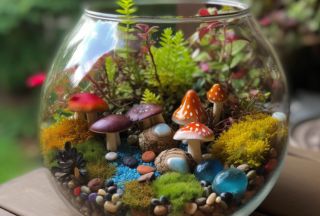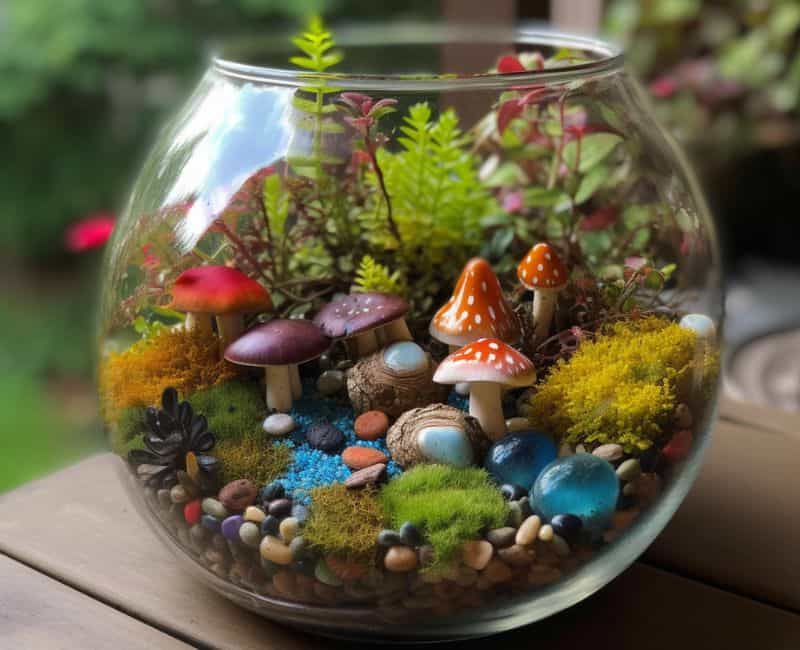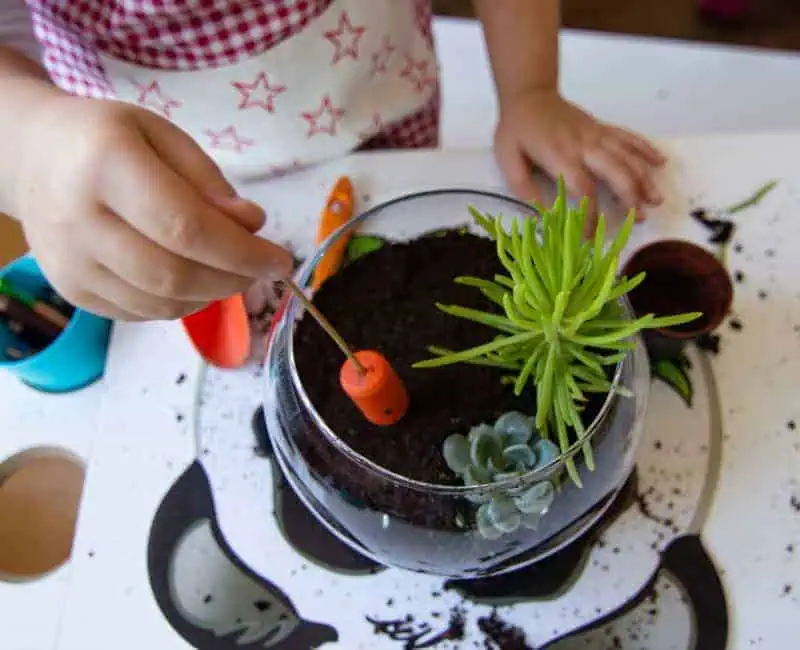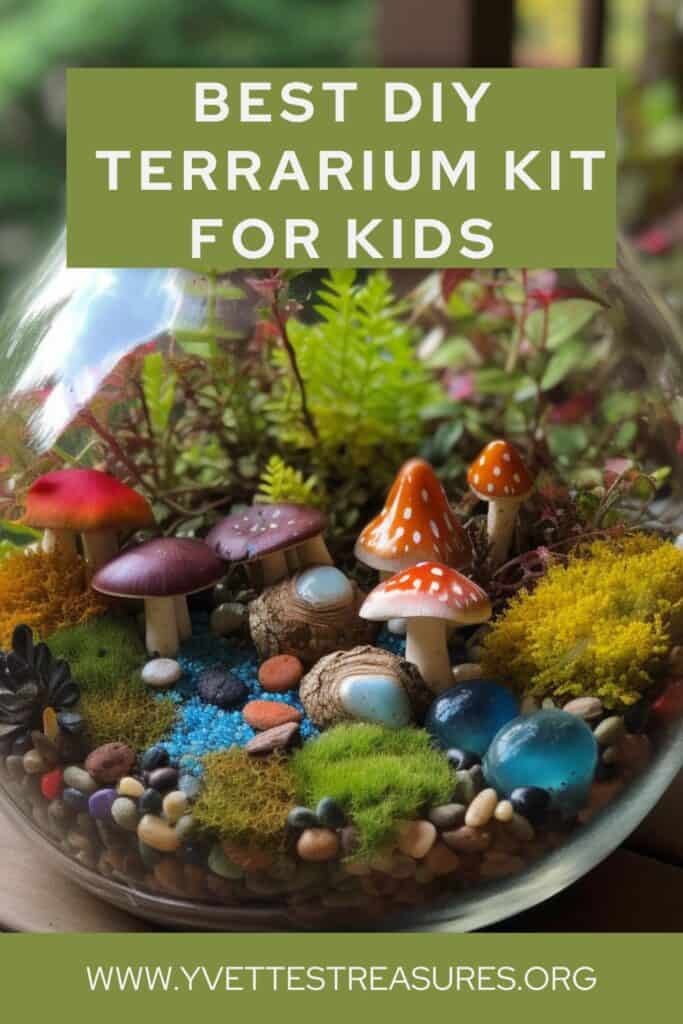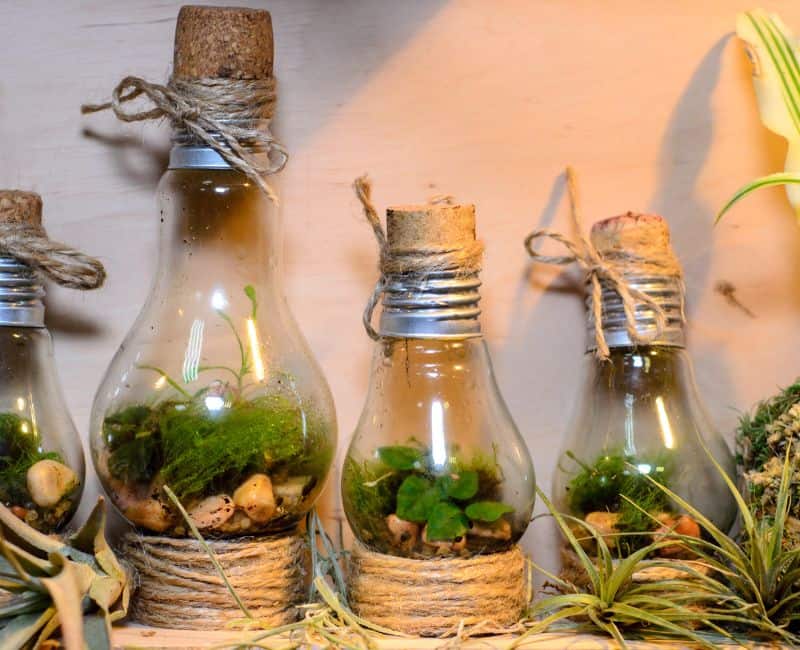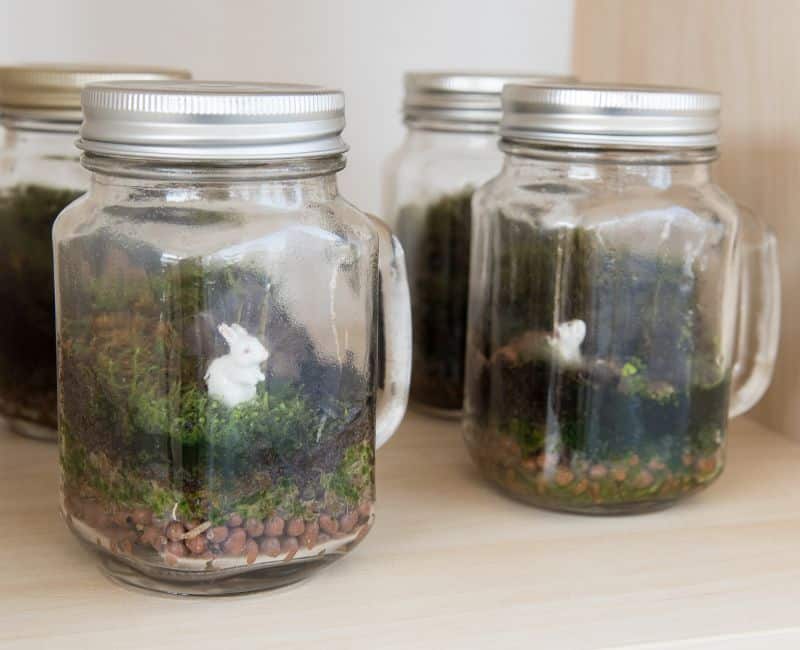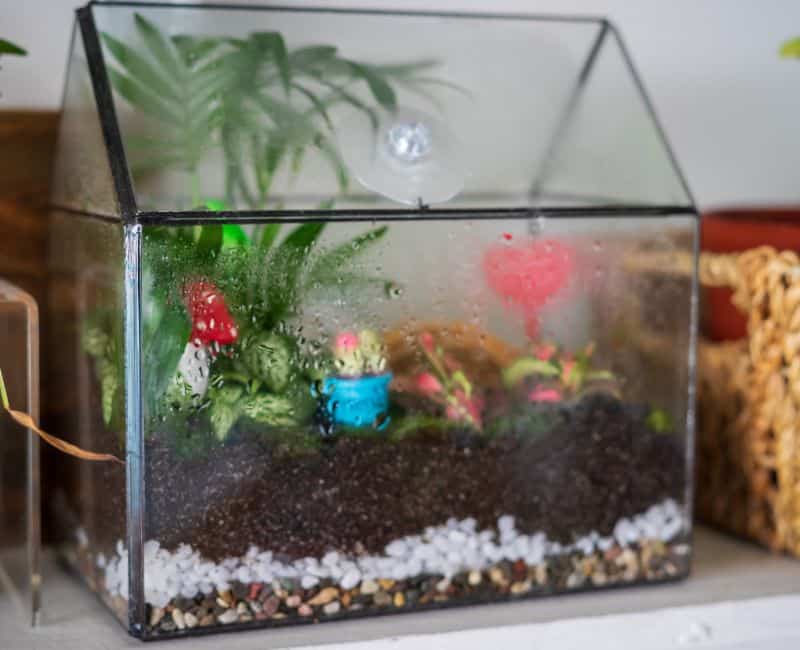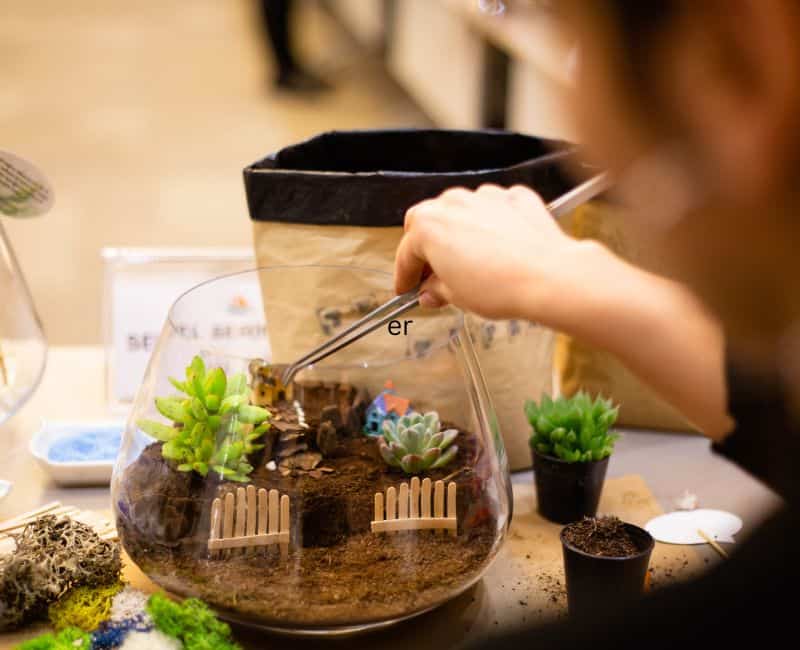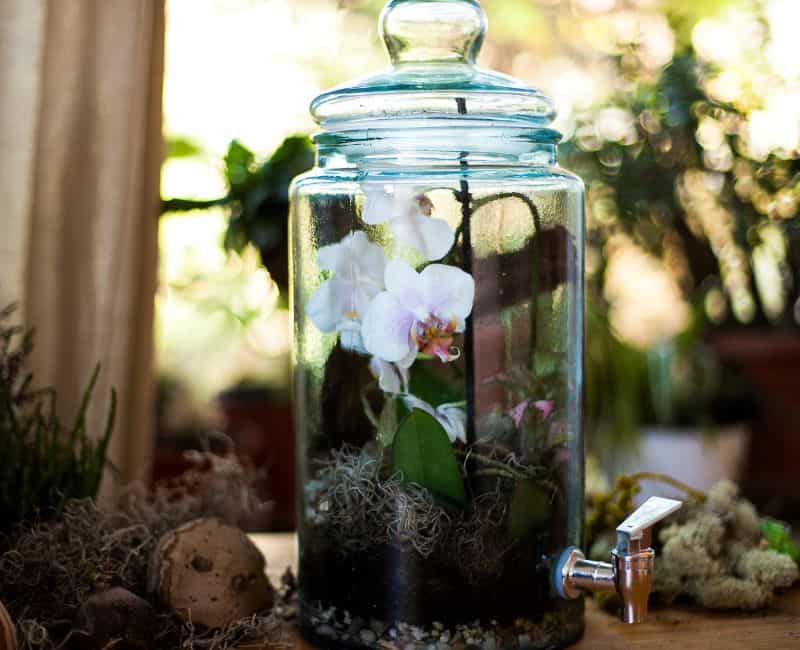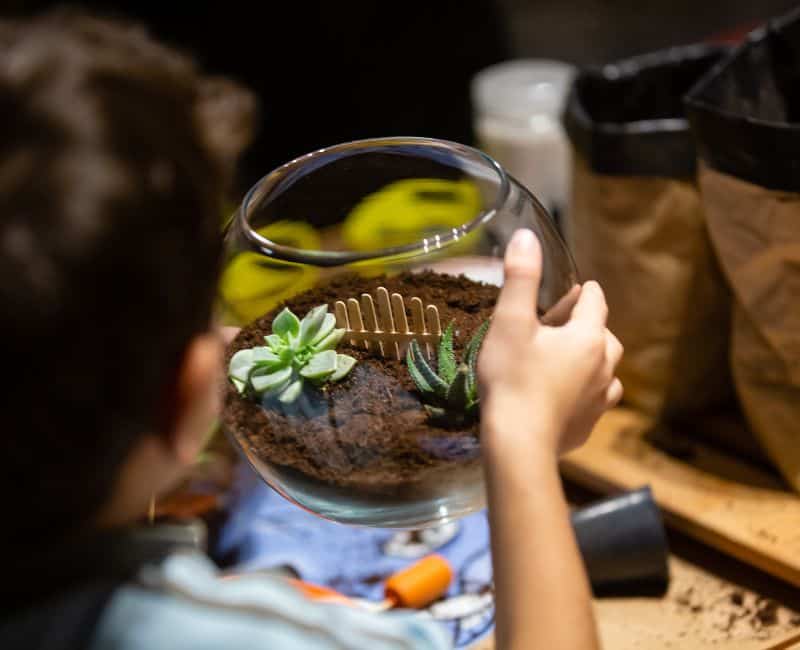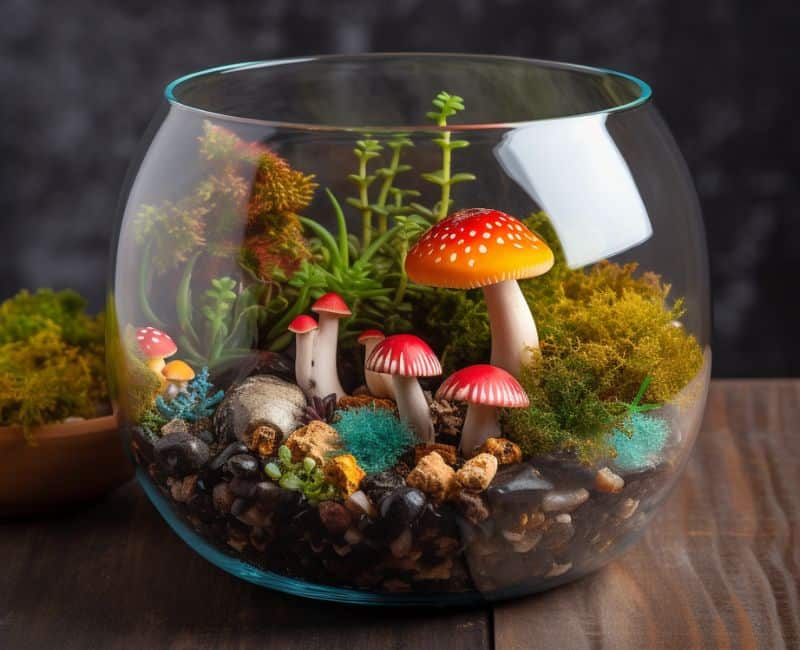This post may contain affiliate links. I may receive commissions for purchases made through these links with no extra cost to you. See full disclosure.
Last Updated on September 21, 2023 by Yvette’s Treasures
DIY Terrarium Kit For Kids A Gift Guide
If you’re looking for the perfect gift that combines creativity, nature, and a touch of personalization, then look no further than the ultimate DIY Terrarium kit for kids gift guide. This article provides a comprehensive overview of everything you need to know about creating your very own terrarium masterpiece.
From selecting the perfect container to choosing the right plants and adding those little finishing touches, this guide has got you covered. So grab your gardening gloves, unleash your inner artist, and get ready to create a gift that is sure to wow and impress.
Should mom or dad not have enough time or space to help the kiddos create a DIY terrarium from scratch, I have listed a few of my favorite DIY terrarium kits for kids from fairy gardens to unicorns and all fun things in between.
Buying a DIY terrarium kit is a great way to get your kids started on this wonderful journey, and to be creative with their hands. I guarantee a lot of fun will be had by all.
Unicorn Terrarium Kit
Light up Unicorn Terrarium Kit for Kids
This colorful unicorn terrarium kit is a great gift for any little girl whether it be a birthday gift or Christmas. This DIY kit is a great product and includes many wonderful accessories such as preserved moss, crystals, magic sand and it even has an LED light with remote control.
Organic Kids Terrarium Grow Kit
Back to the Roots Organic Kids Terrarium Grow Kit – Easy-to-Use DIY Set for All Ages Small
Design and grow your own living garden ecosystem and manage your own growing microgreens with this Terrarium Grow kit. This terrarium starter kit is perfect for kids and parents alike to get started on their own terrarium and plant growing kit!
Benefits of DIY Terrariums
Who wouldn’t want a little piece of nature in their home? DIY terrariums not only bring the beauty of the outdoors inside but also provide several benefits for your overall well-being.
One of the key benefits is that they enhance indoor air quality by absorbing toxins and releasing oxygen. This can greatly improve the air you breathe in your home, especially if you live in an urban area with limited access to fresh air.
Additionally, having a terrarium in your living space can help reduce stress and promote a sense of calmness and relaxation. It’s like having a miniature oasis right at your fingertips!
Enhances indoor air quality
One of the greatest advantages of having a DIY terrarium is its ability to enhance indoor air quality. Plants, especially those found in terrariums, have the unique ability to absorb harmful toxins from the air.
This can greatly improve the air you breathe and create a healthier indoor environment. Studies have shown that having plants in your home can reduce levels of carbon dioxide, formaldehyde, and other pollutants.
So not only do terrariums add a touch of green to your space, but they also help purify the air and promote a healthier lifestyle.
Brings nature indoors
We all have an innate connection to nature, and bringing a piece of it indoors can have a profound impact on our well-being. DIY terrariums offer a simple and effective way to incorporate nature into your living space.
Whether you live in a bustling city or a cozy suburban home, having a terrarium can help bridge the gap between the outdoors and indoors.
It brings a sense of tranquility and serenity, allowing you to escape the chaos of everyday life, even if just for a few moments. With a terrarium, you can create your own little natural haven right in the comfort of your home.
Low-maintenance
For those with busy lifestyles or limited gardening experience, DIY terrariums are the perfect solution. These miniature gardens require minimal care and attention, making them ideal for anyone who wants to enjoy the beauty of plants without the hassle of constant upkeep.
Most terrarium plants, such as succulents and air plants, thrive in low-light and require little watering. This means you can set up your mini terrarium kit and forget about it for weeks at a time, knowing that the plants will continue to thrive on their own. It’s a low-maintenance way to bring a touch of nature into your life.
Great for Small Spaces
Living in a small apartment or a cramped office space doesn’t mean you have to miss out on the joy of having plants. DIY terrariums are a great solution for those with limited space, as they require very little room to thrive.
Their compact size allows them to fit on any desk, shelf, or windowsill, making them a versatile choice for anyone looking to add a touch of green to their surroundings.
With a terrarium, you can turn even the smallest nook or cranny into a beautiful display of nature. It’s the perfect way to make the most of your space and create a soothing environment.
Crystal Unicorn Terrarium Kit
Grow Your Own Crystal Unicorn Terrarium Kit
Choosing the Right Container
When it comes to choosing the right container for your DIY terrarium, there are several options to consider. Each type of container has its own unique characteristics and can create a different aesthetic for your terrarium. Here are some popular choices:
Glass container
These Glass containers are a classic choice for terrariums due to their transparency, which allows you to fully observe the plants inside. They come in various shapes and sizes, ranging from simple bowls to geometric terrariums.
The clear glass creates a sleek and modern look, perfect for contemporary spaces. Additionally, glass containers help create a greenhouse effect, trapping the heat and moisture inside the terrarium, which can be beneficial for certain plant species.
Clear plastic containers
If you’re looking for a more lightweight and affordable option, clear plastic containers may be a suitable choice. They are shatterproof and can be easily found in various shapes, including rectangular, cylindrical, or dome-shaped.
While plastic containers may not have the same aesthetic appeal as glass, they are practical and can still showcase the beauty of your terrarium. They are also lightweight and easy to move around, making them a great option for those who want a portable terrarium.
Mason jar
Mason jars have gained popularity in recent years as a trendy choice for DIY terrariums. The rustic charm of these glass jars adds a unique touch to any space. They come in different sizes, allowing you to create terrariums of various scales.
The narrow opening of the jar can also help create a more controlled environment within the terrarium. However, it’s important to note that the limited space can restrict the types of plants you can choose.
Fish tanks
For those looking to create larger terrariums or wanting to house a variety of plants, fish tanks can be an excellent option. They provide ample space and allow you to experiment with different plant arrangements and landscapes.
Fish tanks also offer good ventilation and can accommodate plants that require high humidity levels. Just ensure that the tank has a tight-fitting lid to prevent excess moisture from escaping.
When selecting a container, consider the size and style of your space, as well as the specific needs of your plants. The right container will not only provide a suitable environment for your terrarium but also enhance the overall aesthetic appeal.
Selecting the Perfect Plants
Choosing the right plants for your DIY terrarium is key to creating a thriving and visually appealing miniature garden. Here are some popular plant options:
Succulents
Succulents are a popular choice for terrariums due to their ability to store water in their leaves, making them drought-tolerant. They come in various shapes, sizes, and colors, allowing you to create interesting and diverse arrangements.
Some popular varieties for a succulent terrarium include Echeveria, Sedum, and Haworthia. They thrive in bright, indirect light and require minimal watering, making them perfect for low-maintenance terrariums.
Cacti
Cacti are another excellent choice for terrariums, especially if you’re looking for plants that can withstand dry conditions. With their unique shapes and spiky textures, cacti add a touch of personality to any terrarium.
They are slow-growing and require infrequent watering, making them a great option for those who are new to terrarium gardening. Just be mindful of the spines and provide enough space for the cacti to grow.
Air plants
Air plants, also known as Tillandsias, are fascinating plants that require no soil to grow. They absorb moisture and nutrients from the air, making them incredibly low-maintenance.
Air plants come in a variety of shapes and sizes, from tiny rosettes to cascading tendrils. They can be placed directly on top of decorative elements such as rocks or moss, making them a versatile choice for terrariums.
To care for air plants, simply mist them with water a few times a week or soak them in water for about an hour every two weeks.
Ferns
Ferns are a classic choice for terrariums due to their lush and delicate fronds. They thrive in high humidity and low light conditions, which makes them perfect for the enclosed environment of a terrarium.
There are many varieties of ferns to choose from, including Maidenhair ferns, Boston ferns, and Bird’s Nest ferns. Ferns require regular watering to keep the soil moist, but not waterlogged. They can add a touch of elegance and vibrancy to your terrarium.
When selecting plants for your terrarium, consider their individual light and humidity requirements, as well as their growth habits.
Mixing different plant varieties can create an interesting visual contrast, adding depth and dimension to your terrarium. Experiment with different combinations to achieve the desired look and feel.
Dinosaur Terrarium Kit for Kids
Dinosaur Terrarium Kit for Kids
DIY Terrarium Kit For Kids Essential Supplies
To ensure the success of your DIY terrarium, it’s important to have the necessary supplies on hand. Here are some essential items you’ll need:
Activated charcoal
Activated charcoal, also known as charcoal or carbon, helps filter the air inside the terrarium and prevents odors. It absorbs impurities and toxins, creating a cleaner and healthier environment for your plants.
Activated charcoal also helps prevent the soil from becoming stagnant and reduces the risk of fungal growth. You can find activated charcoal in granular or pellet form at garden centers or online here.
Potting soil
Good quality potting soil is essential for providing the necessary nutrients and drainage of excess water for your terrarium plants. Look for a well-draining soil mix that is specially formulated for indoor plants, preferably one that is low in organic matter.
Avoid using garden soil as it may contain pests or weed seeds. For best results potting soil should be slightly moist, but not wet when adding it to your terrarium.
Pebbles or stones
A layer of pebbles, stones or small rocks at the bottom of your terrarium is important for drainage. This helps prevent water from pooling at the bottom and causing root rot.
Choose pebbles or stones that are small enough to fit comfortably in your container, but large enough to create adequate drainage layers. They also add a decorative element to your terrarium, enhancing its overall aesthetic appeal.
Decorative moss or lichen
Adding decorative moss or lichen to your terrarium can create a natural and visually appealing landscape. Moss not only adds a splash of vibrant green but also helps retain moisture in the terrarium.
Lichen, on the other hand, adds texture and a touch of character to the overall design. These natural elements can be found in garden centers or online, and they come in various colors and textures to suit your personal style.
Having the right supplies on hand will ensure a smooth and successful terrarium-building process. It’s important to prepare these essentials before you start assembling your terrarium to avoid any delays or setbacks.
DIY Terrarium Kit For Kids Tools You’ll Need
To assemble your DIY terrarium, you’ll need a few basic tools to help with the planting and arrangement process. Here are some essential tools you’ll need:
Gloves
Wearing gardening gloves will protect your hands from dirt, dust, and any potential irritants. They will also prevent any soil-borne pests or bacteria from coming into contact with your skin.
Opt for gloves that are comfortable, but not too thick, allowing you to handle the plants and materials easily.
Small gardening shovel
A small gardening shovel or a trowel is essential for scooping and transferring soil into your terrarium. It helps ensure precision and control while planting your chosen plants.
Look for a shovel with a comfortable grip and a small, narrow blade that can fit into tight spaces within your container.
Long tweezers
Long tweezers or plant grabbers are handy tools for arranging and positioning small plants or delicate elements within your terrarium.
They allow you to reach into narrow spaces without disturbing the soil or risking damage to the plants. Look for tweezers with a non-slip grip for better control and precision.
Spray bottle
A spray bottle filled with water is essential for misting your terrarium plants. This helps create the right level of humidity within the terrarium and provides moisture to the plants without overwatering them.
Look for a spray bottle with a fine mist setting to ensure even distribution and prevent damage to the plants.
Having these tools readily available will make the terrarium assembly process much easier and more enjoyable. They will help you achieve the desired placement and ensure the overall health of your plants.
Space Terrarium Kit
Step-by-Step Terrarium Assembly Guide
Now that you have all the necessary supplies and tools, it’s time to start creating your DIY terrarium. Follow these step-by-step instructions to ensure a successful terrarium-building process:
1. Prepare the container
Thoroughly clean and dry your chosen container before assembling your terrarium. Make sure there are no traces of dust, dirt, or residue that could potentially harm your plants. This step is crucial for maintaining a healthy and clean environment for your terrarium.
2. Add a layer of pebbles
Create a drainage layer at the bottom of your container by adding a layer of pebbles or stones. This will prevent water from pooling at the bottom and causing root rot. The layer should be about 1-2 inches thick, depending on the size of your container.
3. Place activated charcoal
Spread a thin layer of activated charcoal on top of the pebbles. This will help filter the air within the terrarium and prevent any unpleasant odors. Activated charcoal also absorbs impurities and toxins, creating a healthier environment for your plants.
4. Add a layer of potting soil
Add a layer of potting soil on top of the activated charcoal, making sure it is level and evenly distributed. The layer should be deep enough to accommodate the roots of your chosen plants. Leave enough space at the top of the container for arranging and decorating.
5. Arrange the plants
Carefully remove your chosen plants from their pots and gently loosen the roots. Start arranging them in the terrarium, considering their size, growth habit, and light requirements.
Experiment with different heights, textures, and colors to create a visually appealing composition. It’s important to leave enough space between the plants to allow for growth.
6. Decorate with moss or lichen
Once the plants are in place, add decorative moss or lichen to the terrarium. This will add a natural and visually appealing touch to the overall design. Sprinkle the moss or lichen around the base of the plants and in any empty spaces to create a cohesive and lush look.
7. Mist with water
Using a spray bottle filled with water, mist the plants and soil lightly. This will provide the necessary moisture without overwatering the terrarium.
Pay attention to the water requirements of your specific plants and adjust the frequency of misting accordingly. The goal is to keep the soil slightly moist, but not wet.
Congratulations! You have successfully assembled your DIY terrarium. Now it’s time to find the perfect spot to display your creation and enjoy the beauty of nature indoors.
Terrarium Display Ideas
Once your terrarium is assembled, it’s time to think about how you want to display it. There are several creative and unique ways to showcase your terrarium. Here are some ideas to get you started:
Hanging terrariums
If you’re short on surface space, consider hanging your terrarium. You can use decorative macramé hangers or wall-mounted plant holders to create a stunning hanging display.
Hanging terrariums add a touch of greenery to your walls and free up valuable tabletop or shelf space. They are also great for displaying cascading plants such as String of Pearls or Burro’s Tail.
Wooden display stands
Wooden display stands offer a rustic and natural look for your terrarium. They elevate the terrarium off the ground, creating a focal point in any room. Look for stands that are specifically designed for terrariums or DIY your own using reclaimed wood.
Wooden stands come in various shapes and sizes, allowing you to customize the look of your display.
Vintage glass cloches
For a more whimsical and enchanting display, consider placing your terrarium under a vintage glass cloche. These decorative glass domes add a touch of elegance and nostalgia to your terrarium.
They create a mini greenhouse effect, trapping moisture and heat inside, which can be beneficial for certain plant varieties. Vintage glass cloches can be found at antique stores or online.
Terrarium jewelry
Take your terrarium display to the next level by turning it into wearable art. Terrarium jewelry, such as necklaces, bracelets, or rings, allow you to keep a tiny piece of nature close to your heart.
Nature Dry Flower Terrarium Necklace
These miniature terrariums are often encapsulated in glass or resin, creating a unique and eye-catching piece of jewelry. Terrarium jewelry also makes for a thoughtful and personalized gift. Here are a few mini glass container ideas.
With these display ideas, you can turn your terrarium into a stunning focal point that complements your personal style and adds a touch of natural beauty to your surroundings.
Terrarium Necklace Nature Jewelry Miniature Flower Mini Glass Bottle
Caring for Your Terrarium
Proper care and maintenance are essential for keeping your terrarium healthy and thriving. Here are some tips for caring for your terrarium:
Watering
Most terrarium plants, such as succulents and air plants, prefer infrequent watering. It’s important to find the right balance between not enough and too much water. The soil should be slightly moist but not waterlogged or completely dry.
Use a spray bottle or a misting wand to lightly water the plants, taking care not to overwater. Monitor the moisture level of the soil and adjust the watering frequency accordingly.
Lighting
Terrariums typically thrive in moderate to bright, indirect light. Place your terrarium in a location where it can receive sufficient light, but avoid direct sunlight, as it can cause the plants to burn or overheat.
If natural light is limited, you can use artificial grow lights designed for indoor plants. The distance between the light source and the plants should be appropriate for the specific light requirements of your chosen plants.
Pruning
Regular pruning is necessary to maintain the shape and health of your terrarium plants. Remove any dead or yellowing leaves, as well as any growth that appears overcrowded or leggy.
Pruning also helps promote new growth and prevents the plants from becoming too large or overpowering. Use clean, sharp shears or scissors to make clean cuts, avoiding any damage to the remaining plant material.
Cleaning
Over time, dust and debris may accumulate on the leaves and inside the terrarium. It’s important to regularly clean your terrarium to maintain its overall appearance and prevent any potential pest infestations.
Gently wipe the leaves with a soft, damp cloth or use a soft-bristle brush to remove any dust. You can also use a small vacuum or compressed air to clean hard-to-reach spots.
By following these care tips, you can ensure that your terrarium remains healthy and beautiful for years to come. The joy of having a thriving mini garden in your home is just a little care and attention away.
Terrarium Accessories and Decorations
To add a personal touch and enhance the overall aesthetic of your terrarium, consider incorporating accessories and decorations. Here are some ideas to inspire you:
Miniature figurines
Tiny figurines, such as fairies, animals, or mythical creatures, can add a whimsical touch to your terrarium. These miniature characters create a sense of enchantment and evoke a storybook-like atmosphere.
Look for figurines that are specifically designed for terrariums or experiment with small toys or trinkets that fit within the scale of your container.
Tiny furniture
For a more realistic and detailed terrarium, consider adding miniature furniture such as benches, tables, or chairs. These tiny elements create a sense of place and add a human-like touch to your terrarium.
Look for miniature furniture made from weather-resistant materials, as they will be exposed to the humidity and moisture within the terrarium.
Colorful stones or crystals
Adding colorful stones or crystals to your terrarium can create a vibrant and eye-catching display. Look for polished gemstones or natural crystals in various shapes and colors.
These decorative elements can be placed around the base of the plants or arranged in attractive patterns. They add depth and spark to your terrarium, creating a mesmerizing visual experience.
Fairy lights
For a magical and whimsical touch, incorporate fairy lights into your terrarium. These tiny LED lights create a warm and enchanting glow within the terrarium.
Choose battery-operated lights that are safe to use indoors. Arrange the lights around the plants or hang them above the terrarium for a captivating nighttime display.
With these accessories and decorations, you can personalize your terrarium and create a unique and captivating display that reflects your personal style and imagination.
Terrarium Mistakes to Avoid
While DIY terrariums are relatively low-maintenance, there are a few common mistakes to be aware of. Avoiding these pitfalls will help ensure the success and longevity of your terrarium. Here are some mistakes to avoid:
Overwatering
One of the most common mistakes when it comes to terrarium care is overwatering. It’s important to remember that most terrarium plants, especially succulents and air plants, prefer dry conditions.
Overwatering can lead to root rot and other fungal diseases, which can rapidly deteriorate the health of your plants. Monitor the moisture level of the soil and adjust your watering frequency accordingly.
Using the wrong soil
Choosing the right potting soil is essential for the health of your terrarium plants. Avoid using garden soil, as it may contain pests or weed seeds that can harm your plants.
Look for a well-draining potting mix that is specifically formulated for indoor plants. The soil should be slightly moist but not waterlogged or too dry.
Neglecting light requirements
Light is crucial for the growth and development of your terrarium plants. Pay attention to the specific light requirements of your chosen plants and place your terrarium in an appropriate location.
While most terrarium plants thrive in bright, indirect light, some may require more or less light. Adjust the placement of your terrarium accordingly to ensure that your plants receive the right amount of light.
Not cleaning the container
Regular cleaning is important for maintaining the overall appearance and health of your terrarium. Dust and debris can accumulate on the leaves and inside the terrarium over time, hindering the growth of your plants and attracting pests.
Regularly wipe the leaves with a soft cloth and clean the inside of the container to prevent any potential issues.
By avoiding these common mistakes, you can ensure that your terrarium thrives and provides you with a beautiful and captivating display.
DIY terrariums offer a wonderful opportunity to bring a piece of nature into your home. They enhance indoor air quality, provide a sense of tranquility, require minimal maintenance, and are perfect for small spaces.
By carefully selecting the right container, plants, supplies, and tools, you can create a thriving and visually appealing terrarium that adds beauty to your living space.
Follow the step-by-step assembly guide, explore creative display ideas, and take proper care of your terrarium to enjoy the benefits of nature right at your fingertips. Happy terrarium gardening!
- 27 BBQ Gift Ideas For Men That They Will Love! - July 22, 2024
- The Best Halloween Baby Shower Theme Ideas And Games - July 11, 2024
- Bouncy Pals Unicorn: The Best Playmate for Kids - July 7, 2024
